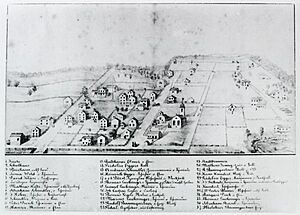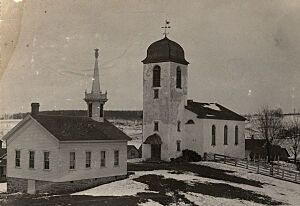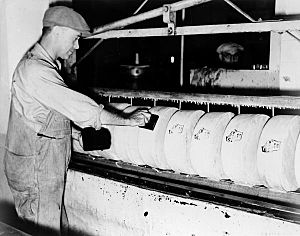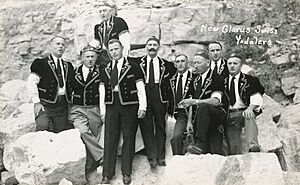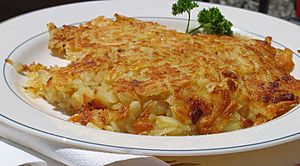New Glarus, Wisconsin facts for kids
Quick facts for kids
New Glarus, Wisconsin
|
|
|---|---|
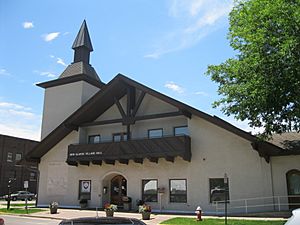
New Glarus Village Hall
|
|
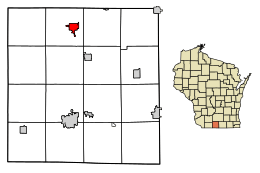
Location of New Glarus in Green County, Wisconsin.
|
|
| Country | |
| State | |
| County | Green |
| Founded | 1845 |
| Area | |
| • Total | 1.80 sq mi (4.65 km2) |
| • Land | 1.80 sq mi (4.65 km2) |
| • Water | 0.00 sq mi (0.00 km2) |
| Elevation | 900 ft (274 m) |
| Population
(2020)
|
|
| • Total | 2,266 |
| • Density | 1,261.0/sq mi (486.8/km2) |
| Time zone | UTC-6 (CST) |
| • Summer (DST) | UTC-5 (CDT) |
| Area code(s) | 608 |
| FIPS code | 55-56700 |
| GNIS feature ID | 1570216 |
New Glarus is a small village in Green County, Wisconsin, United States. In 2020, about 2,266 people lived there. This special village was started in 1845 by people who moved from a place called canton of Glarus in eastern Switzerland. That's where New Glarus gets its name! You can find New Glarus where Wisconsin Highways 69 and 39 meet, close to the bigger city of Madison.
Contents
History of New Glarus
How New Glarus Started
In the early 1840s, people in the canton of Glarus in Switzerland faced tough times. Their crops failed, and there wasn't enough food or jobs. The government thought moving to America could help. So, in 1844, they created the Glarus Emigration Society. This group offered loans to help people buy land in the New World.
People had to pay for their own trip to America. Men were offered 20 acres of land for free for ten years. After that, they could buy it for a very low price. Because things were so hard in Switzerland, 193 brave people decided to leave and start fresh in America.
In 1845, two men, Nicolas Duerst and Fridolin Streiff, were sent ahead. Their job was to find a good spot for the new settlement. They had $2600 to buy land and build cabins for the settlers who would arrive later.
Duerst and Streiff looked for land in Ohio, Indiana, and Illinois. They then traveled to St. Louis, Missouri. In July 1845, they went north to Galena, Illinois, and then to Mineral Point, Wisconsin. They explored different areas in southern Wisconsin. Finally, they chose two square miles along the Little Sugar River. On July 17, 1845, they bought 1,200 acres for $1.25 per acre. The land was a fertile valley with hills and many trees, reminding them of Switzerland.
This land was wild and had been home to Native Americans for many years. An old Indian trail ran just south of where New Glarus is now. This trail later became an important road for the settlers.
The families in Switzerland were eager to leave. They left earlier than planned, on April 10, 1845. They expected to sail to New York City. But dishonest agents sent them to Baltimore, Maryland instead. After a 49-day journey, they arrived in America. They didn't know where Duerst and Streiff were, but they started their difficult journey west.
Along the way, the Swiss pioneers heard rumors that Duerst and Streiff had died. But they kept going. When they reached St. Louis, they were tired, hungry, and covered in mosquito bites. From there, they took a steamboat to Galena, Illinois.
In Galena, they were thrilled to learn that Duerst and Streiff were alive! The land for their new home was ready. Excited, 18 men walked 62 miles that night to the settlement. Wagons were then sent back for the rest of the immigrants. After a long journey of four months and five days, 108 settlers arrived at their new home on August 15, 1845. Sadly, three people died on the way. Others found work or friends elsewhere, but many more joined the colony the next year.
Life in the Early Years
The New Glarus settlers bought 1,200 acres for their new village. Many of the pioneers were carpenters, mechanics, and farmers. These skills were very helpful as they got ready for their first winter in the Wisconsin Territory. They used $1,000 to buy tools, cows, seeds, and other supplies. They had to pay this money back within ten years.
That first winter, twelve families lived in the community's only wooden hut. It was built where the Swiss United Church of Christ stands today. They mostly ate potatoes and grated cheese, a dish called Röschti. They also caught fish from the Little Sugar River. Bread and meat were very rare. To earn money, they worked in nearby lead mines in Exeter and Mineral Point.
Things slowly improved. In 1851, the first store opened in New Glarus. The first hotel opened in 1853, and the first cheese factory in 1870.
More immigrants from "Old Glarus" in Switzerland arrived over the years. By 1870, 1,247 people born in Switzerland lived in Green County, Wisconsin. The small 20-acre plots of land owned by the first settlers grew to over 30,000 acres around New Glarus by 1878.
The settlers paid back all the money they borrowed from Switzerland, plus interest! Later, in 1861, a terrible fire destroyed much of the town of Glarus, Switzerland. Over 3,000 people lost their homes. The people of New Glarus sent more money back to Switzerland than they had originally borrowed. In 1881, when a huge rockslide buried much of Elm (also in Glarus), killing 114 people, New Glarus helped again. They sent $20,000 to their old homeland.
Even though they had only been in America for a short time, 98 men from New Glarus fought for the Union in the American Civil War. The village also helped in other American wars. During World War II, the Swiss Miss Textile Mart and Lace Factory in New Glarus made patches for U.S. military uniforms. Walter Gabriel Schindler, born in New Glarus, earned special awards for his bravery in that war. Kevin Patrick Lynch from New Glarus also received a Navy Cross in World War II. In 2001, Henry Janisch, from New Glarus, was one of the first Marines to enter the War in Afghanistan.
Dairy Farming and Cheese Making
After their first winter, the people of New Glarus bought cows from Ohio. This was the start of dairy farming and cheese making in the village. Many settlers already knew how to make cheese from their families in Switzerland. Soon, there were many dairy cows, and selling dairy products became a good way to earn money.
Nickolaus Gerber, who moved from New York, started the first cheese factories in New Glarus. He built the area's first Limburger cheese factory. He also built America's first Swiss cheese factory (also known as Emmental in Switzerland) near New Glarus.
After the American Civil War, New Glarus became very successful because of its cheese production. In 1905, New Glarus had 22 cheese factories! It was said that the town's roads were busy with daily milk deliveries. New Glarus quickly became known as the "Cheese Capital of the World."
Today, only one Limburger cheese factory remains near New Glarus. It's the last one of its kind in North America! Even though Limburger cheese isn't as popular now, the area around New Glarus still has the most specialty cheese factories and award-winning cheesemakers in the United States.
In 1910, the Helvetia Milk Condensing Company opened a factory in New Glarus. They made sweetened condensed milk. This factory quickly became the biggest employer in the village. It bought a lot of milk from local farms, which caused many smaller cheese factories to close. In 1923, the company changed its name to Pet Milk Company.
In 1962, the Pet Milk Company closed its factory in New Glarus. This changed the town a lot. Businesses related to farming, like cheese factories and farm equipment stores, disappeared. But this closure also led New Glarus to focus on tourism. The village started to promote its unique Swiss history and culture.
Growing Tourism in New Glarus
Before World War II, the farming and dairy industries in New Glarus faced economic problems. Many people left to find work elsewhere. Leaders in the village worried about the future of their Swiss community. They asked the University of Wisconsin–Madison and the Swiss American Historical Society for ideas. They decided that tourism could help the local economy and keep their Swiss identity alive.
Local businesses began to change. They actively promoted New Glarus's Swiss heritage. Buildings in the village started to look like Swiss chalets. Festivals that were once just for locals became popular with tourists from all over the Midwest. By 1999, the village even made a rule that new buildings and renovations had to follow Swiss architectural styles.
Arnold Wieser, who owned the Swiss Miss Textile Mart and Lace Factory, became a great promoter for New Glarus. As he traveled selling his embroidery and Swiss lace, he told everyone about the village and its Swiss roots.
Roger Bright, a polka band leader, also helped spread the word about New Glarus. His band played in many states, Canada, and Europe. His Cleveland-style polka music had a Swiss touch, and he always promoted New Glarus wherever he played. Roger Bright's music was on 35 albums. He even appeared on famous TV shows like The Tonight Show Starring Johnny Carson and the Phil Donahue Show.
Important Events in New Glarus
- In 1887, the Milwaukee Road built a railroad line to New Glarus. This brought passengers and goods to and from the rest of the country. It became very profitable because of all the milk and cheese shipments. People called it the "Limburger Express." The line closed on March 30, 1972. Today, 24 miles of the old railroad line from New Glarus to Brodhead, Wisconsin is now the Sugar River State Trail. People use it for biking, snowmobiling, and enjoying nature. The old train station, the Chicago, Milwaukee and Saint Paul Railroad Depot, was restored and added to the National Register of Historic Places in 2000.
- In 1905, there was a funny idea proposed: that Limburger cheese should be used as "money" to pay debts in the area!
- In 1960, Senator John F. Kennedy visited New Glarus while campaigning for president.
- In 1968, three Amish farmers in New Glarus refused to send their 14 and 15-year-old children to high school. They were fined for breaking Wisconsin's school law. This led to a famous court case, Wisconsin v. Yoder. In 1972, the United States Supreme Court decided that Amish children did not have to go to school past eighth grade. This was because it went against their right to freedom of religion.
- Deb Carey, who started the New Glarus Brewing Company, was a special guest of President Barack Obama at his State of the Union speech in 2013.
- The New Glarus High School boys' basketball team won their first state championship in any sport on March 16, 2019!
Geography of New Glarus
New Glarus covers about 1.8 square miles of land. It is part of the larger Madison metropolitan area.
Population of New Glarus
| Historical population | |||
|---|---|---|---|
| Census | Pop. | %± | |
| 1890 | 356 | — | |
| 1910 | 708 | — | |
| 1920 | 981 | 38.6% | |
| 1930 | 1,010 | 3.0% | |
| 1940 | 1,068 | 5.7% | |
| 1950 | 1,224 | 14.6% | |
| 1960 | 1,468 | 19.9% | |
| 1970 | 1,454 | −1.0% | |
| 1980 | 1,763 | 21.3% | |
| 1990 | 1,899 | 7.7% | |
| 2000 | 2,111 | 11.2% | |
| 2010 | 2,172 | 2.9% | |
| 2020 | 2,266 | 4.3% | |
| U.S. Decennial Census | |||
New Glarus in 2020
In 2020, New Glarus had 2,266 people. Most people (94%) were White. There were also small numbers of Asian, Black, and Native American people. About 2.9% of the population was Hispanic or Latino.
New Glarus in 2010
In 2010, there were 2,172 people living in New Glarus. About 96.9% of the people were White. About 2.6% of the population was Hispanic or Latino.
The average age in the village was 40.5 years. About 23.3% of residents were under 18 years old.
Language Spoken in New Glarus
The original language spoken in New Glarus was Glarnerdütsch. This is a special kind of Swiss-German dialect. It came from the town of Glarus in Switzerland. Today, the Glarner language in New Glarus has many old words and pronunciations. These are not heard in Switzerland anymore. Mostly older people in the area still speak it. It is rarely heard in daily life now.
You can find recordings of this special dialect at the Max-Kade Institute for German-American Studies.
Economy of New Glarus
Tourism is the biggest part of New Glarus's economy. Many people visit the village because of its Swiss heritage.
Some of the biggest employers in New Glarus are:
- Link Snacks, Inc. (makes Jack Link’s Beef Jerky)
- The New Glarus School District
- New Glarus Home (a care facility)
- New Glarus Brewing Company
- New Glarus Hotel & Landhaus
- Bank of New Glarus
The average income for a household in the village was $45,000. About 6.6% of the people lived below the poverty line.
New Glarus Brewing Company
In 1993, Deborah and Dan Carey started the New Glarus Brewing Company. Deborah Carey was the first woman in the United States to start and run a brewery! The brewery quickly grew. In 2004, they built a new, larger brewery. It cost $21 million and was 75,000 square feet. The brewery has expanded many times since then and is now over 115,000 square feet. They are even expanding again in 2023!
Even though New Glarus Brewing Company only sells its beer in Wisconsin, it is one of the largest craft breweries in the United States.
Swiss Center of North America
In 1999, New Glarus was chosen to be the home of the Swiss Center of North America. This center helps keep Swiss culture alive and celebrates it. Other big cities like Chicago, New York, and Toronto were considered. But New Glarus was chosen because it's in a central spot and has many Swiss Americans living nearby.
The Swiss Center has a research library, historical records, exhibits, and meeting rooms. Over $3 million was raised to build it. Money came from the U.S. government, the State of Wisconsin, the Canton of Glarus, and companies like Nestle USA and Victorinox.
Transportation
A railroad line to New Glarus was finished in 1887. It was part of the Chicago, Milwaukee, St. Paul and Pacific Railroad. People called this route "The Limburger Special." It was very busy carrying milk and cheese. Train service to New Glarus stopped in 1972. This was ten years after the Pet Milk plant closed, which had provided most of the freight for the train.
Soon after, the Wisconsin Department of Natural Resources bought the old railroad path. It later became the Sugar River State Trail. The old New Glarus station is now a historic place listed on the National Register of Historic Places.
Arts and Culture in New Glarus
New Glarus is a popular place for tourists. It's famous for its Swiss heritage, old-style buildings, Swiss food, and fun outdoor festivals.
Even after more than 160 years, New Glarus still keeps many of its Swiss traditions. You can see Swiss-style chalets and flower boxes with red geraniums on the streets. Swiss flags fly next to American flags at many businesses and homes. In downtown New Glarus, you'll find old-world meat markets, restaurants, a Swiss bakery, folk art, museums, and Swiss-style shops.
Many Swiss customs are still practiced in New Glarus. These include the card game Jass, yodeling, and flag tossing. Today, New Glarus is known as the most famous Swiss settlement in America.
Museums to Visit
- Chalet of the Golden Fleece
- Swiss Village Historical Museum
Fun Festivals and Events
New Glarus has many exciting events throughout the year:
- Silvesterchlausen (a New Year's tradition)
- Winterfest
- World Euchre Championship (a card game)
- Roger Bright Memorial Polkafest
- New Glarus Beer, Bacon & Cheese Festival
- Heidi Festival
- Volksfest (Swiss National Day celebration)
- Wilhelm Tell Festival (a play about a Swiss hero)
- New Glarus Oktoberfest
- Kilby Supper
- Saint Nicholas Day
- New Glarus Family Fest
- New Glarus Christkindli Market (a Christmas market)
Delicious Swiss Food
Even though New Glarus is small, it's known for many traditional Swiss dishes. Some of these foods are hard to find outside of Switzerland! Here are some foods you can try in New Glarus:
- Röschti (or Rösti) – This is like the national dish of Switzerland and a favorite in New Glarus. The early Swiss settlers ate it when they first arrived. Röschti is made with grated potatoes, onions, Swiss cheese, and fresh herbs. It's fried and shaped into rounds or patties. It used to be a breakfast dish, but now you can find it as a side dish at most restaurants in New Glarus.
- Kalberwurst – This is a sausage with a special creamy flavor. It came from the Canton of Glarus. Kalberwurst is made with veal, milk, ground crackers, and mild spices. It has a smooth texture and a mild taste. Unlike most sausages, it's not smoked. It's often cooked with onions and gravy. Many Swiss restaurants in New Glarus serve kalberwurst. It's also a special dish at the village's yearly Kilby Supper.
- Spaetzli (or Spätzle) – Spaetzli are small, boiled, and fried dumplings. They are made with eggs, flour, and salt. The word spaetzli means "small sparrows," which describes their tiny shape.
- Landjaeger (or Landjäger) – This is a dried sausage made with beef, pork, lard, sugar, and spices. Landjaegers are often eaten as snacks. They are pressed into a mold, which gives them a unique rectangular shape. During World War II, Landjaegers were sent to soldiers from New Glarus because they didn't need refrigeration. The word Landjaeger means "gamekeeper." This sausage has become very popular and is sold in many stores and taverns throughout southern Wisconsin.
- Braetzeli – A braetzeli is a very thin cookie that tastes like almond and vanilla. Handmade braetzelis are difficult and take a long time to make. They are cooked on a special Swiss iron that presses a pretty pattern onto both sides of the cookie.
Other Swiss foods you might find in New Glarus include bratwurst, fondue, Älplermagronen (Alpine macaroni), Zopf (braided bread), chaeschuechli (cheese tarts), schnitzel, chocolates, and Swiss Stollen (a fruit bread).
Notable People from New Glarus
- John Closner, a developer and rancher
- Ernst J. Hoesly, a legislator and businessman
- Herbert Kubly, an author
- Solomon Levitan, a Treasurer of Wisconsin
- John Luchsinger, a legislator and writer
- Jody Samson, a knifemaker
- S. A. Schindler, a politician and businessman
- Walter Schindler, a U.S. Navy Vice Admiral who received several awards for bravery
- Theodore G. Streissguth, a legislator and businessman
- Jefferson F. Wescott, a legislator
- Stan Zweifel, an American football coach
|
See also
 In Spanish: New Glarus (Wisconsin) para niños
In Spanish: New Glarus (Wisconsin) para niños


